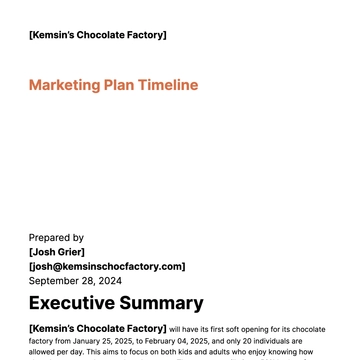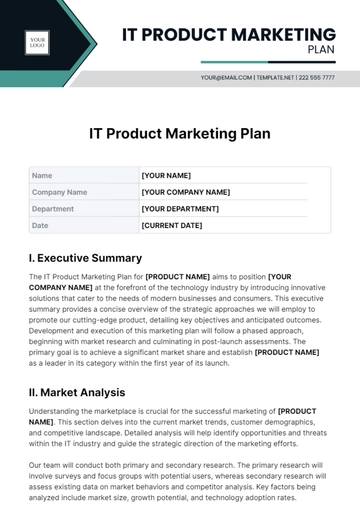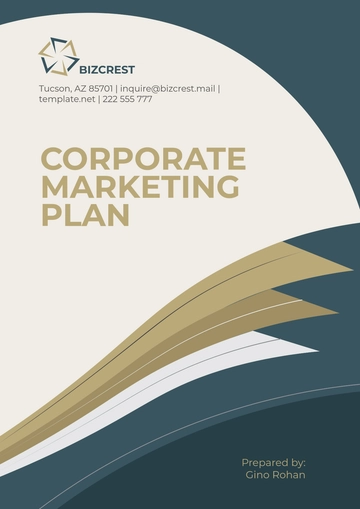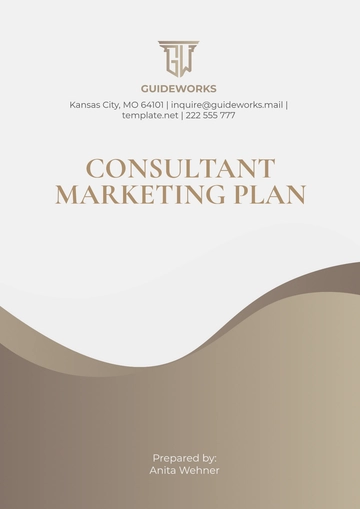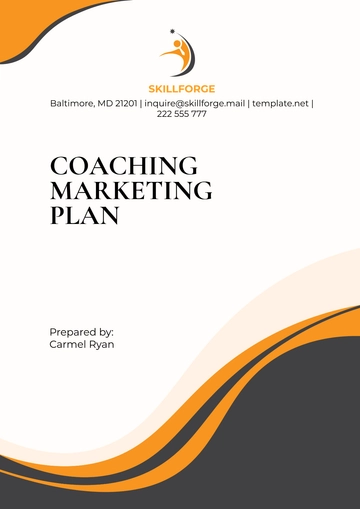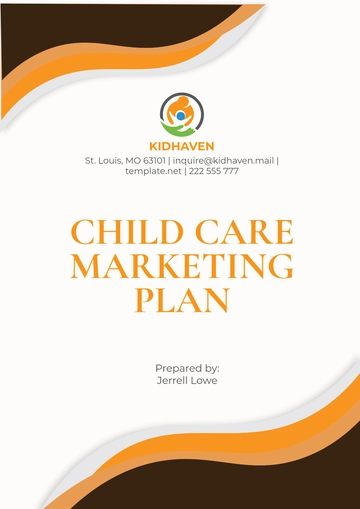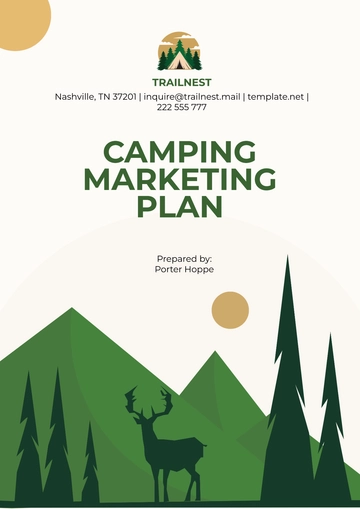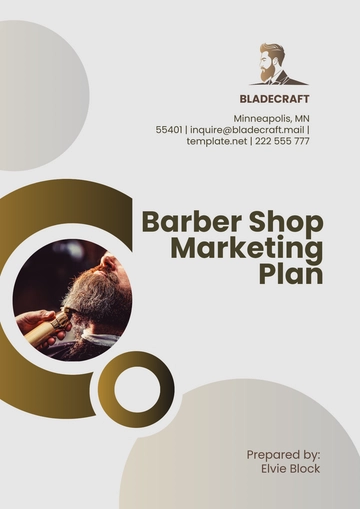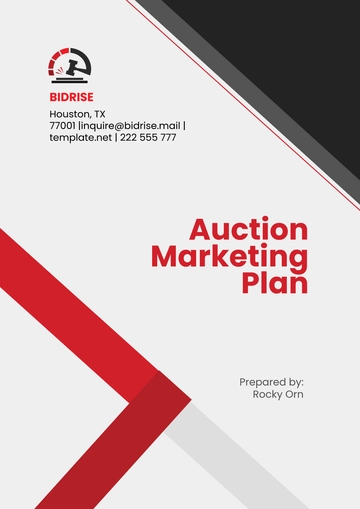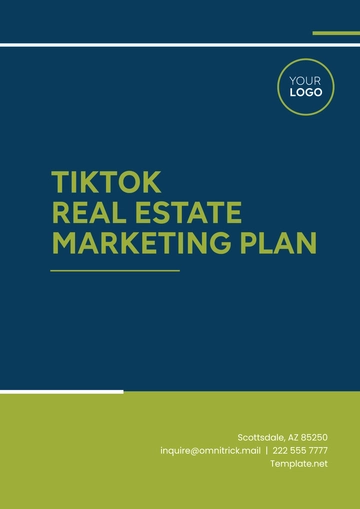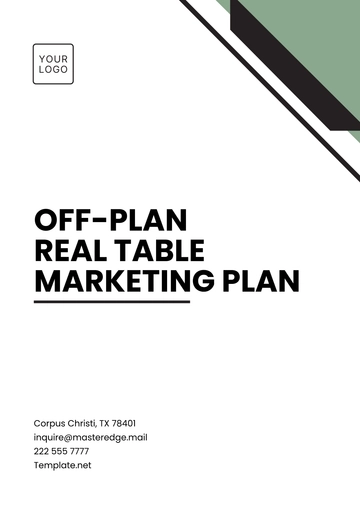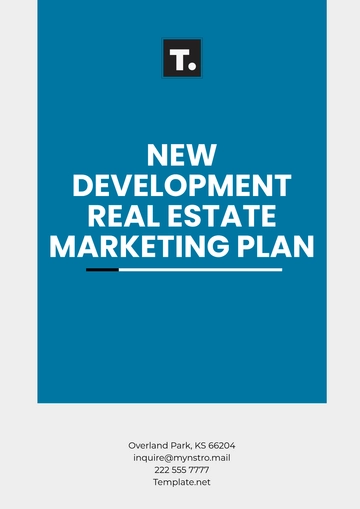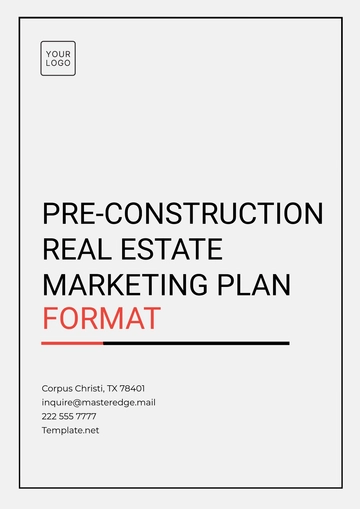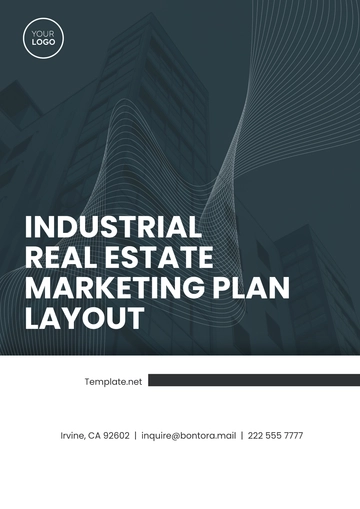Free Financial Advisor Marketing Plan
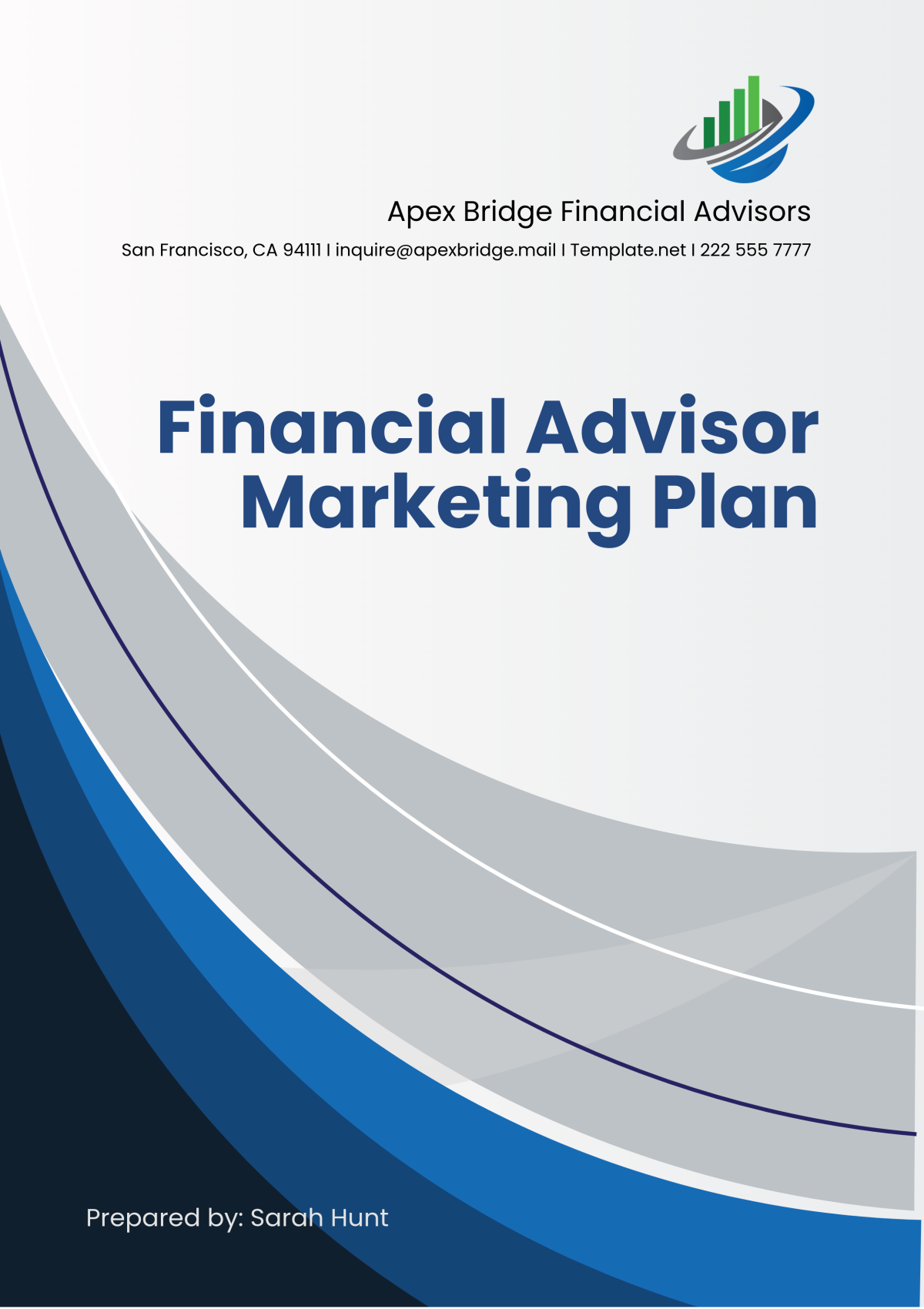
I. Executive Summary
A. Overview
The financial advising industry is projected to experience substantial growth by [2050], driven by an increasing demand for personalized financial services and wealth management solutions. In this competitive landscape, it is crucial for [Your Company Name] to develop a robust and adaptable marketing plan that focuses on enhancing brand visibility, attracting new clients, and retaining existing ones. This marketing plan outlines strategies that aim to increase revenue by [30%] within the next [12] months. To achieve this goal, the plan will leverage various marketing channels, including digital platforms, customer referrals, and tailored financial solutions. The primary target audience includes high-net-worth individuals (HNWIs), small business owners, and retirees who seek comprehensive financial guidance and long-term wealth management.
B. Goals and Objectives
The primary goal of this marketing plan is to grow [Your Company Name]’s client base and increase revenue through innovative marketing strategies. The specific objectives are as follows:
Increase brand awareness by [20%] through targeted digital marketing campaigns by the end of [2050]. This will involve enhancing online visibility and outreach to attract potential clients.
Achieve a [15%] growth in new client acquisition by targeting key demographics that align with our services. This will be accomplished through focused advertising and outreach efforts.
Increase the client retention rate by [25%] through personalized services and ongoing relationship-building efforts, ensuring that clients feel valued and supported.
Strengthen partnerships with [Your Partner Company Name] and other key financial institutions to enhance referral opportunities and collaborative service offerings.
Enhance overall client satisfaction ratings to over [90%] through tailored services and continuous engagement.
C. Financial Projections
This marketing plan anticipates the following key financial outcomes over the next [12] months:
Increase the marketing budget by [$50,000] to support enhanced digital and offline marketing efforts, including social media, direct mail, and events.
Projected new client revenue increase of [$500,000] within the next year, driven by targeted lead generation and strategic marketing initiatives.
Client retention efforts to generate an additional [$250,000] from existing customers by enhancing client relationships and service offerings.
Overall projected revenue increase to [$1,202,500], reflecting robust client acquisition and retention strategies.
II. Market Research
A. Industry Analysis
The financial advisory industry is undergoing significant transformation with trends such as the rise of robo-advisors, increased focus on Environmental, Social, and Governance (ESG) investing, and greater demand for personalized financial solutions. By [2050], the industry is expected to become more personalized and technology-driven, with clients actively seeking advisors who understand both traditional financial planning and modern technological applications. According to data from industry analysts, the financial advisory industry is forecasted to reach a valuation of approximately [$8 trillion] by [2060]. As clients increasingly prioritize tailored advice and strategic planning, it is critical that [Your Company Name] adapts to these trends and positions itself as a leader in personalized financial services.
B. Target Market
1. Demographics
[Your Company Name] will primarily focus on the following key demographic groups:
High-net-worth individuals (HNWIs): Typically over the age of [40], earning an annual income of over [$200,000], and possessing investment portfolios exceeding [$1 million]. This group often seeks sophisticated investment strategies and wealth preservation solutions, including estate planning and tax optimization.
Small business owners: Entrepreneurs and business owners seeking assistance with financial planning for their businesses, retirement solutions, and succession planning. They often require guidance on managing cash flow, taxes, and employee benefits, making them ideal clients for comprehensive financial services.
Retirees: Individuals aged [60+] who are planning for wealth preservation, estate planning, and retirement income strategies. This demographic is increasingly concerned about ensuring their savings last throughout retirement and will benefit from tailored solutions that align with their retirement goals.
2. Psychographics
Our target clients are generally characterized by the following psychographic traits:
Financially conscious: They are proactive in seeking to secure and grow their wealth, often researching and comparing different financial products and services before making decisions.
Value personalized service: They prioritize long-term relationships with their advisors, favoring those who understand their unique goals and concerns. They appreciate a customized approach that addresses their specific financial needs.
Concerned about financial security: They are particularly focused on tax optimization, risk management, and ensuring that their wealth is preserved for future generations, indicating a need for ongoing financial education and support.
C. Competitive Analysis
[Your Company Name] faces competition from both traditional financial institutions and emerging fintech platforms. Key competitors include:
Competitor | Strengths | Weaknesses |
|---|---|---|
[Competitor A] | Established brand, comprehensive services, and a strong online presence. | Higher fees, which may deter price-sensitive clients. Less personalized service, leading to lower client engagement. |
[Competitor B] | Low-cost robo-advisor platform with automated portfolio management. | Limited personal interaction, which may lead to client dissatisfaction and potential attrition. |
[Competitor C] | Specializes in retirement planning with a well-defined niche market. | Smaller range of financial services, which may not meet all client needs and can limit growth opportunities. |
[Your Company Name] can differentiate itself by offering a hybrid approach that combines personalized advisory services with advanced digital tools, ensuring clients receive the best of both worlds. By focusing on high-quality service delivery and building long-term relationships, [Your Company Name] can gain a competitive edge in the financial advisory landscape.
III. Marketing Strategy
A. Branding and Positioning
[Your Company Name] will position itself as a premium financial advisory firm focused on delivering personalized financial planning solutions that align with client goals. The branding will emphasize trust, expertise, and a commitment to helping clients achieve their financial objectives. The slogan, “Your Trusted Partner in Financial Growth,” will be consistently used across all marketing materials to reinforce brand identity and messaging.
To enhance brand visibility, [Your Company Name] will create a compelling logo and color scheme that conveys professionalism and reliability. Additionally, all marketing collateral—ranging from brochures and business cards to digital assets—will maintain a consistent look and feel, ensuring that potential clients can easily recognize the brand.
B. Marketing Channels
1. Digital Marketing
1.1 Website and SEO Optimization
The company’s website is a crucial part of its online presence. To attract potential clients, [Your Company Name] will invest in Search Engine Optimization (SEO) to rank higher in search results for terms such as “financial advisor near me” and “wealth management services.” The website will be designed to be user-friendly, with clear navigation, informative content, and easy-to-find contact information.
In addition, the website will feature a blog that provides valuable insights into current market trends, investment strategies, and financial planning tips. This content will not only position [Your Company Name] as a thought leader but also improve SEO rankings through fresh and relevant content.
SEO Budget: [$10,000]
Expected Traffic Growth: [25%] over the next year, which translates to approximately [1,500] new visitors per month.
Conversion Rate Goal: [3%], equating to [45] new clients monthly from the website.
1.2 Social Media Marketing
Social media platforms such as LinkedIn, Facebook, and Twitter will be utilized to build an online community and engage with potential clients. Regular posts on market trends, financial tips, and company updates will help establish the brand’s reputation as an expert in the field. Additionally, targeted ads will be utilized to reach specific demographics based on age, income, and interests.
Regular engagement on social media, including responding to comments and messages, will enhance client relationships and foster community. Social media campaigns will also include client testimonials and success stories to build trust and credibility.
Social Media Ad Budget: [$8,000]
Projected Follower Increase: [10,000] followers across all platforms.
Engagement Rate Goal: [7%], leading to increased interactions and inquiries.
2. Traditional Marketing
2.1 Direct Mail Campaigns
Despite the rise of digital marketing, direct mail remains a powerful tool for reaching affluent clients. [Your Company Name] will send out personalized mailers to high-net-worth individuals, featuring exclusive offers for financial reviews and consultations. This personalized approach will help establish a connection before any face-to-face meetings.
Direct Mail Budget: [$5,000]
Response Rate Goal: [3%], resulting in approximately [150] inquiries from mailed pieces.
Estimated New Clients: [50], translating to a potential revenue of [$150,000].
2.2 Print Media
Advertising in financial magazines and newspapers will help reach a broad audience of investors and business owners. The advertisements will highlight [Your Company Name]’s expertise in financial planning and its focus on personalized services. This traditional medium continues to hold value in the financial sector.
Print Media Budget: [$7,000]
Expected Reach: [50,000] readers across various publications.
Lead Conversion Rate: [2%], leading to approximately [1,000] potential inquiries.
C. Referral Program
To incentivize current clients to refer new business, [Your Company Name] will introduce a referral program. Clients who refer new customers will receive discounts on their advisory fees or special rewards, such as exclusive invitations to financial planning workshops. This program not only encourages client engagement but also leverages existing relationships to grow the client base.
Referral Program Budget: [$5,000]
Expected New Clients from Referrals: [50], generating approximately [$150,000] in revenue.
D. Educational Events and Webinars
[Your Company Name] will host educational webinars and live events covering topics such as retirement planning, investment strategies, and estate planning. These events will provide valuable insights while showcasing the expertise of [Your Company Name]. Additionally, they will serve as an excellent opportunity for networking and client engagement.
Event Budget: [$20,000]
Projected Attendance: [200] participants per event.
Expected New Clients: [25] clients from events, translating to revenue of [$125,000].
IV. Client Retention Strategy
A. Personalized Client Experience
To retain clients and enhance satisfaction, [Your Company Name] will implement a personalized service model. Each client will be assigned a dedicated advisor who will offer tailored financial solutions and regular check-ins. This model fosters strong relationships and encourages open communication about clients' evolving needs and goals.
Client Relationship Management (CRM) tools will be employed to track client interactions and preferences, ensuring that advisors are well-informed about each client's financial situation and objectives. This personalized approach will set [Your Company Name] apart from competitors who may offer more generic services.
B. Client Feedback and Continuous Improvement
Regular client feedback will be collected through surveys and feedback forms to understand their experiences and areas for improvement. This feedback will inform service adjustments and enhance overall client satisfaction. Regular check-in calls and satisfaction surveys will help ensure that clients feel valued and heard.
Feedback Mechanism Budget: [$3,000]
Satisfaction Rate Target: [90%] positive feedback from clients.
Expected Feedback Participation: [75%] of clients responding to surveys.
C. Educational Content and Resources
To provide ongoing value to clients, [Your Company Name] will produce and distribute educational content, including newsletters, market updates, and webinars. This will keep clients informed about market trends and solidify the company’s role as a trusted advisor. Educational content will be tailored to the specific interests of clients, ensuring relevance and engagement.
Content Budget: [$6,000]
Expected Engagement: [70%] of clients accessing educational resources regularly.
Projected Increase in Client Retention: [15%] due to ongoing education and support.
V. Financial Projections
A. Marketing Budget Breakdown
To effectively execute the marketing strategies outlined in this plan, [Your Company Name] will allocate a total marketing budget of [$50,000] as follows:
Marketing Channel | Budget ($) | Expected Outcome ($) |
|---|---|---|
Digital Marketing | [$20,000] | [$300,000] |
Traditional Marketing | [$15,000] | [$100,000] |
Referral Program | [$5,000] | [$150,000] |
Events and Webinars | [$10,000] | [$200,000] |
B. Revenue Projections
By implementing the strategies outlined in this plan, [Your Company Name] expects the following revenue growth over the next [12] months:
Revenue Source | Current Revenue ($) | Projected Increase (%) | Projected Revenue ($) |
|---|---|---|---|
New Client Acquisition | [500,000] | [15] | [575,000] |
Client Retention | [250,000] | [25] | [312,500] |
Referral Program | [100,000] | [20] | [120,000] |
Partnership Referrals | [150,000] | [30] | [195,000] |
Total Projected Revenue: [$1,202,500]
C. Profit and Loss Projection
Based on the expected revenues and costs outlined in this marketing plan, a preliminary profit and loss projection for the upcoming year is as follows:
Financial Metric | Amount ($) |
|---|---|
Total Revenue | [1,202,500] |
Total Marketing Expenses | [50,000] |
Net Profit | [1,152,500] |
Profit Margin (%) | [95.84] |
VI. Performance Tracking and Adjustments
A. Key Performance Indicators (KPIs)
To measure the success of this marketing plan, the following KPIs will be tracked on a monthly basis:
Website Traffic: Monitoring the number of visitors and lead conversions through analytics tools will help assess the effectiveness of digital marketing efforts.
Social Media Engagement: Analyzing engagement rates (likes, shares, comments) and follower growth will provide insight into audience interaction and content effectiveness.
New Client Acquisition: Tracking the number of new clients acquired each month will help measure the success of lead generation and referral programs.
Referral Program Participation: Evaluating the number of clients participating in the referral program will help determine its effectiveness and potential areas for improvement.
Client Retention Rates: Monitoring client retention rates and satisfaction scores will provide insight into overall client satisfaction and areas for service enhancement.
B. Marketing Plan Adjustments
The marketing plan will be reviewed quarterly, and adjustments will be made based on the performance metrics. Underperforming channels will be re-evaluated, and additional budget will be allocated to high-performing initiatives such as SEO or referral programs. For instance, if social media campaigns yield high engagement but low conversions, [Your Company Name] may consider optimizing the landing pages associated with those ads to improve conversion rates.
VII. Conclusion
By implementing this comprehensive marketing plan, [Your Company Name] will be well-positioned to increase its client base, enhance client retention, and achieve significant revenue growth over the next year. Through a combination of digital marketing, traditional outreach, and personalized client services, [Your Company Name] will establish itself as a leader in the financial advisory industry. By delivering tailored solutions that meet the evolving needs of its clients, [Your Company Name] is poised to navigate the dynamic financial landscape of [2050] and beyond, ensuring long-term success and sustainability. This strategic approach will not only secure a stronger market position but will also foster meaningful relationships that are essential in the financial advisory space, ultimately ensuring that clients achieve their financial goals with confidence.
- 100% Customizable, free editor
- Access 1 Million+ Templates, photo’s & graphics
- Download or share as a template
- Click and replace photos, graphics, text, backgrounds
- Resize, crop, AI write & more
- Access advanced editor
Boost your practice with the Financial Advisor Marketing Plan Template from Template.net. This editable and customizable template provides a structured approach to developing marketing strategies, identifying target markets, and tracking results. Personalize it using our Ai Editor Tool to align with your branding and growth objectives.

